My Story
The Creation of the New Millennium’s Most Distinguishable Ciphers
The Evolution of the Cryptogram as Applied, Conceptual Art
A Fifty-Year History of Devotion to My Linear Graphics & Cipher Development
1972
The Birth of a New Art Movement
Trithemian Web™ – A traditional substitution cipher concealed within a conceptual composition. Applied art featuring an interactive design and a problem-solving goal.
Trithemian Web™ Cryptograms feature the use of an elongated character set to conceal a code within a conceptional, artistic presentation. These interactive, designer ciphers represent an evolution of the cryptogram. My infatuation with a 70’s bar challenge initiated my 50 plus year journey.
I am the only cryptographer working in the physical or digital realm using linear graphics, my trademark, to unveil a traditional substitution cipher and RGB identification to reveal the hidden secrets within a single-layer raster file.
Based on the definition of genre (a category of artistic, musical, or literary composition characterized by a particular style, form, or content) my definitive style represents a new movement – Linear Transmutation.
I’ve spent over fifty years perfecting a design methodology that would capture and preserve personal thoughts for generations to come. Following is my story.
“Generations from now my thoughts will remain, hidden within the cryptograms that bear my name.”
70’s Bar Challenge Resurrected!
My fifty-year journey begins here – 1972. This is the year I graduated from the University of Arizona. I was now back in Charleston, SC where I did most of my growing up. One evening, while visiting one of my local watering holes, a fellow patron presented me with a small, square of paper and asked if I could read the message it contained.
Here’s the scenario. If I could read the message, he would buy me a drink. If I could not read it, I would buy him a drink. It’s a bar challenge. They come in all forms. I took him up on it. Here’s an example of that paper square. This graphic is a representation. The original is long gone.
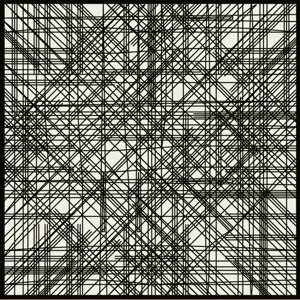
Well, I couldn’t discover the message, so I owed the fellow a drink. He then proceeded to explain how to read this spider web. The letters become readable when viewed on a horizontal plane. It took me a while, but I finally got it. Wow! Amazing. That little piece of paper started me on a journey that has lasted fifty+ years. Oh, there is the red spider.
(2022) My goal is to employ the bar challenge’s linear graphic style to reveal a traditional text-based substitution cipher while bringing the combination into the realm of conceptual art with an unmistakably distinctive style. All of my Trithemian Web™ compositions contain one or more linear graphic lettering sequences, either visible, partially hidden, or mostly hidden, making my ciphers uniquely identifiable.
Would you like to become fully immersed in my linear graphic evolution? Print this pdf. It features an enlarged version of the bar challenge representation. How To View is included.
This representation does employ spaces between words, making it easier to understand. Trithemian Web™ ciphers do not have word spaces.
Note: This sample piece is not encrypted. For more on ciphers, I recommend reviewing the Instructions page.
1978
That piece of paper had captured my imagination. I wanted to pass along the exhilaration I felt when I finally discovered the secrete to the challenge. I kept experimenting with alphabets and design variations.
This is the year I started working with liquid resins. Could I encapsulate these linear graphics in a cube? I used India ink in an architectural pen to draw the lines, first on a yellow layer and then on a clear layer. It worked. Man, I thought I really had something here. No one, to my knowledge, had done this before. Now, what could I do with it? Yes, I still have this original cube.
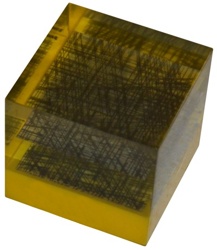
It is small – a little less than two inches square. This success got me thinking. Could I produce a larger version? And what if I could get my creation into a major art festival? My path wasn’t totally clear, but I designed and produced a large cube along with a miniature I planned to offer as a limited edition.
1979
Charleston, SC is home to one of the largest art festivals in the world – Spoleto USA. I attended many of the events and exhibits over the past two years. Gian Carlo Menotti and co-founder Countess Alicia Paolozzi created the original festival in Spoleto, Italy in 1958. Menotti envisioned a festival of two world’s, so he searched for a second venue. Acting on input from the Countess, Menotti chose Charleston.
This world renowned art festival is right in my backyard. The Spoleto cubes are ready. Now how could I get into this festival? I wasn’t a highly regarded artist or designer. I had designed and produced a kinetic sculpture featuring my linear graphics concept. So what. That wouldn’t be enough to get my cube into any major venue. What to do? Where there’s a will there’s a way.
Enter Heyward Hammersley. He was a US Customs inspector and a good friend of my mom’s. I had known Heyward for years. Great guy. Long story short, he knew Countess Paolozzi, arranged a meeting with her, and my Spoleto cube ended up in one of the high traffic venues – the Gaillard Auditorium now the Gaillard Center.
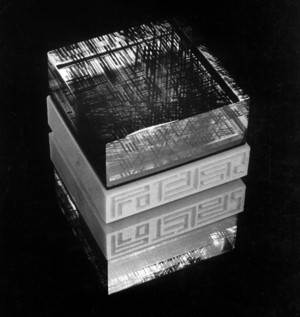
Photograph of the miniature used for brochures.
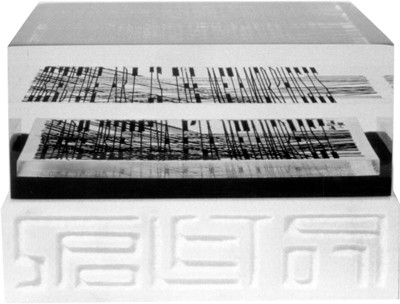
Photo taken on a horizontal plane so one can see how the linear graphics can be read. The cube is read in four separate directions. It has two levels – the top one being in English and the bottom layer in Italian.
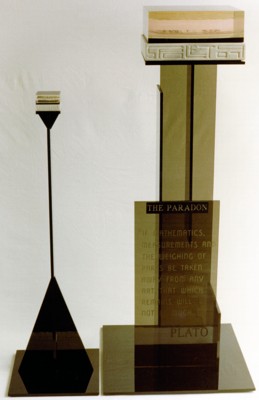
Display of the large cube and its miniature edition.
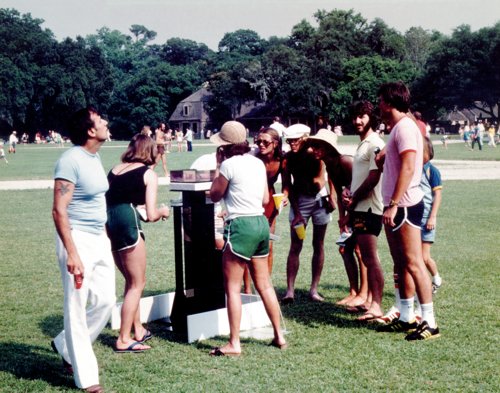
The finale of the 1979 Spoleto Festival was held outdoors at Middleton Place Plantation. Thousands of people would be attending, so I moved the Spoleto cube to take advantage of the final day. The cube is a kinetic piece – it moves the audience. You have to circle the cube in a clockwise direction to read all segments of the encapsulated verses. There were people circling the exhibit all day.
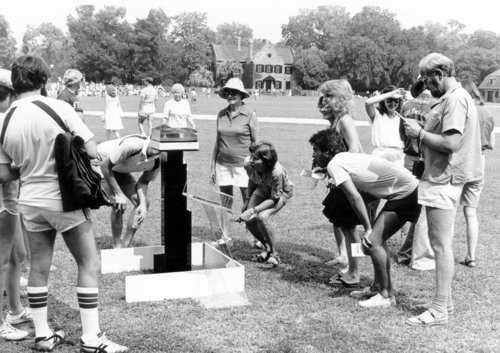
After the festival was over four people ordered miniatures. I had to make each one. There were no shortcuts. It was very time consuming. The Spoleto Festival undertaking attracted a lot of cube viewers, but that was about it. I looked forward to 1980. I made a new discovery.
1980
Although Spoleto 1979 didn’t lead to any riches or recognition I stll planned to introduce a new piece at Spoleto 1980. I called the piece Black Magic.
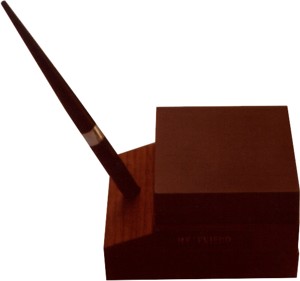
I did a lot of experimenting with resins. One of my trials was unusual to say the least. I took a quarter inch thick piece of black Lucite and drew a set of linear graphics using black India ink. Black on black.
I then proceeded to overlay the black Lucite with 3/4″ of clear resin. The result was surprising. When you looked at the cube from above it appeared to be solid black. When you looked through the cube it appeared crystal clear and the linear letters appeared silver. It’s a very interesting phenomenon. I called it Black Magic.
This pen set has a Black Magic cube positioned on a walnut pen holder. I was considering this desk set as a commercial venture. This proved to be unrealistic at the time due to the cost to commercially manufacture these cubes. That was in 1980. Maybe they could be produced at a reasonable cost today (2022).
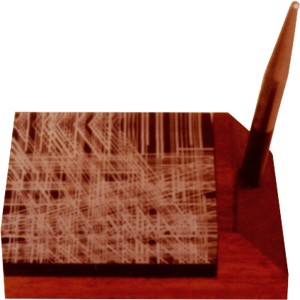
Desk set with a cube that uses white letters on a black Lucite base.
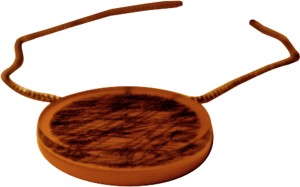
Wearable medallion experiment.

Experiment using a mirror with a clear cube using black letters.
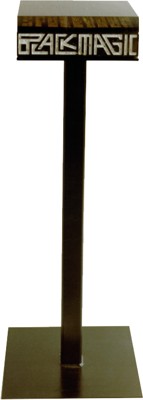
This is the large Black Magic cube I showed in Spoleto 1980. No miniatures were offered because of limited demand in 1979. I can’t remember where I showed this piece.
I never considered myself a marketing expert. Everything I did up to now was an attempt to commercialize a new idea. So far no luck. The following four pieces were sent to well known people in a promotional effort. Each piece had a verse specifically written for them.
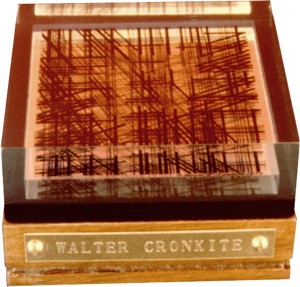
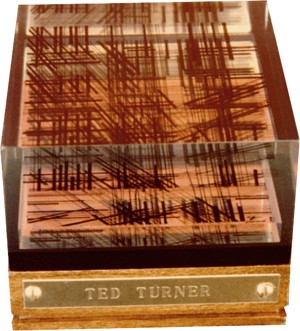
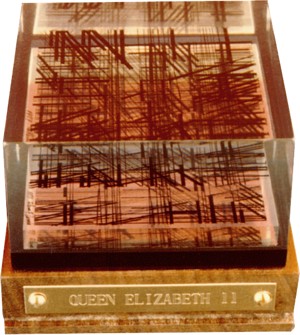
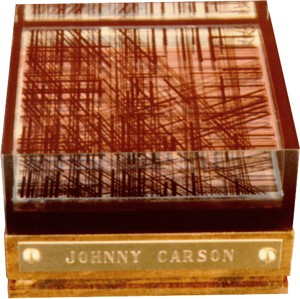
1981
It has been a busy year. Kata Billups, an artist whose works have been collected by many celebrities, and I tried another promotional option. We decided to organize a birthday party for Gian Carlo Menotti, the Spoleto Festival founder. It would be called The Unicorn Ball. We would each produce a special piece that would be presented to Menotti. We hoped for some publicity or recommendations from the meistro. That never happened.
The organization, promotion and execution of this party was a nightmare. Lots of politics. It’s a very long story. To keep it short, the party happened. Menotti and other dignitaries attended. The pieces presented to Menotti were taken and stored out of sight in the Dock Street Theater. There was no thank you or acknowledgement.
After the festival was well over and Menotti had returned to Italy, the pieces languished in the theater. Kata and I went to the Dock Street and retrieved our work. I have Kata’s light box and the One Life’s Spiral sculpture in my bedroom today (2022).
Please excuse the photos. We didn’t have a professional photographer at the ball.
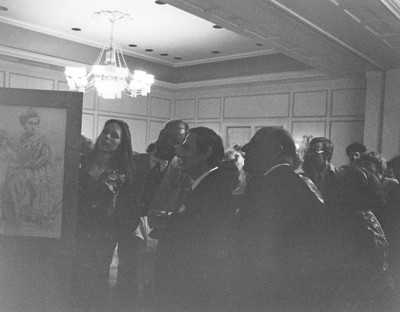
Kata Billups and Gian Carlo Menotti looking at Kata’s light box – a three sided piece. The intensity of an interior light changes the images. She developed the technique. I’ve never seen anything like it.
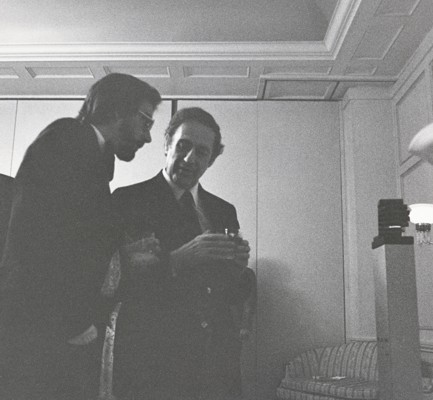
Gian Carlo Menotti and me beside my sculpture – One Life’s Spiral.
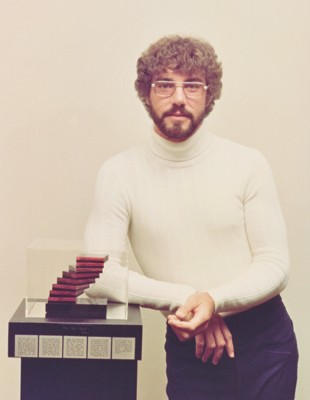
One Life’s Spiral and me.
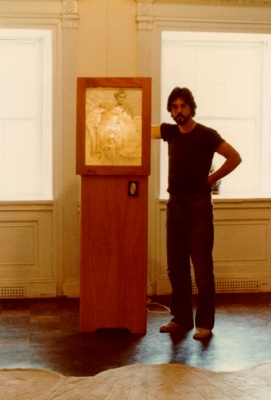
Kata’s Light box.
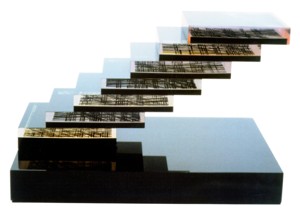 The Arena sculpture.
The Arena sculpture.
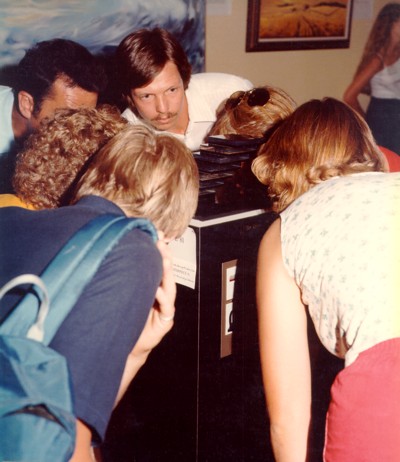
Art show in Ohio. Viewers circled the sculpture all day.
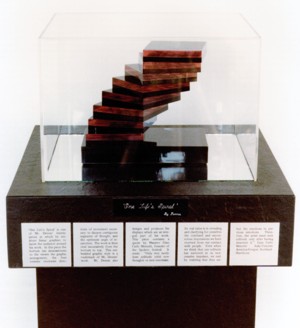
One Life’s Spiral sculpture.
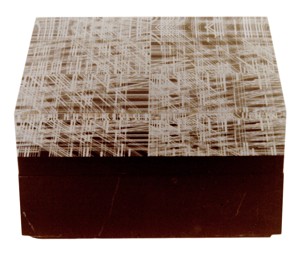
The Ten Commandments. Lucite mounted on black granite. The letters were silk screened onto a black Lucite plate. This small piece has four separate quadrants that contain all ten commandments. This piece is all Lucite, not poured resin.

Truth sculpture.
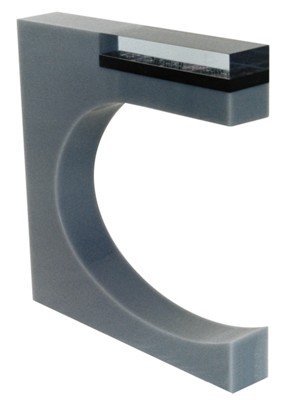
The Law sculpture.
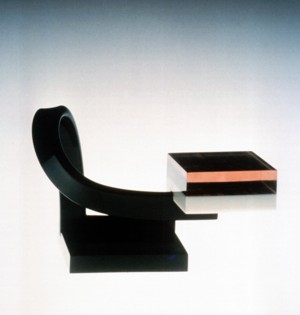
Retiring sculpture.
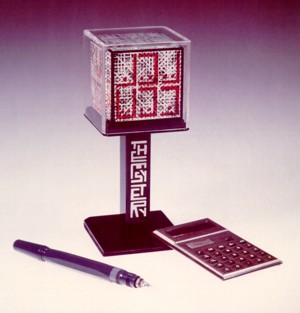
The Mystery Cube.
The Mystery reflects another thought on a commercial application. I designed a cube that was much more difficult to solve than the Rubik’s Cube.
This was possibly a workable project if I just had the necessary funds to have the thing manufactured. Unfortunately, I did not.
I did attempt to attract investors to start the ball rolling, but that was unsuccessful.
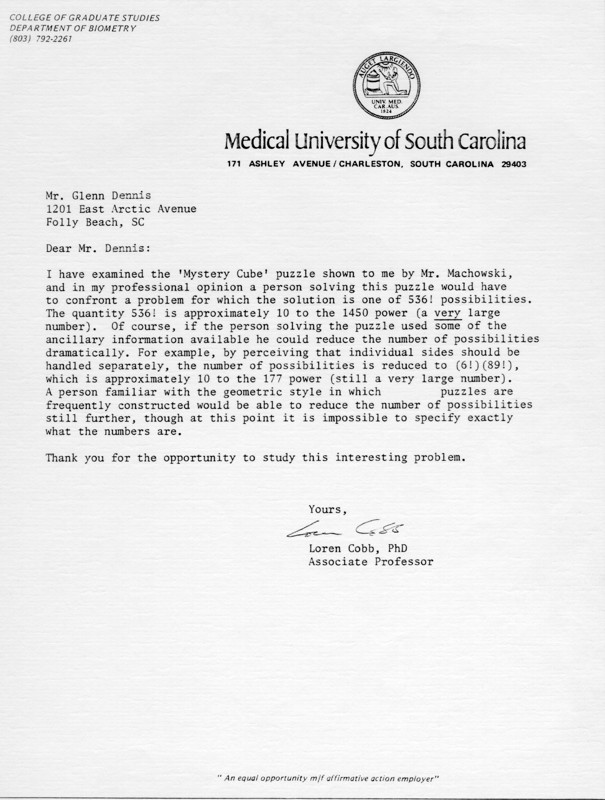
GO BIG
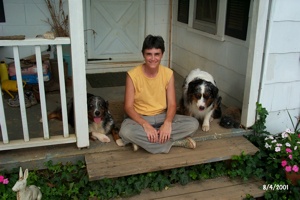
I looked over my autobiography trying to determine the year Kata and I traveled to New York. I settled on 1981, but it could have been anywhere from 1978 to 1982. I believe we drove up from Charleston in my Volkswagen Beetle. We went up to take in some art shows and visit friends in the city. In addition, we made a side trip to Greenwich, CT to visit the mother of one of Kata’s best friends – Hutsie. Pictured at left in 2001.
I must have shown my portfolio to Judy, or she saw my work when she visited Charleston. Neither Kata nor I could definitively remember. Anyway, Judy recommended that I GO BIG. I assumed she meant very large pieces, not lots of small ones. I’m sure she was commenting from an art perspective.
2020: I spoke with Kata in early 2020. She reminded me that Judy told me to GO BIG!
1982
It was a lean year. Working with resins and not using a breathing apparatus was not very smart. I started to see blood in my urine. Methyl ethyl ketone may have been the culprit. Using a respirator and trying to concentrate on drawing thin letters on Lucite was not possible, so I stopped making resin sculptures altogether. If I wanted to keep working with my linear graphics, I had to switch to a non-resin format.
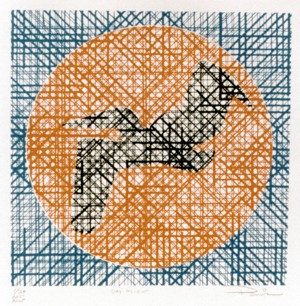
Day Flight – Silkscreen on paper. 16″ x 16″. This was my first attempt making a larger, printed piece that could be framed and displayed. It was small enough to be taken off the wall and viewed horizontally to read its message.
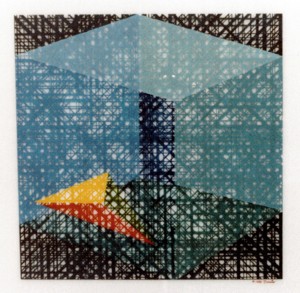
Within Without – Painting on Lucite. 24″ x 24″. This was my first and last painting. I framed this piece and added glass for protection. July 2021 update. I took it off the wall and tried to read it. Impossible. The glass was too reflective.
1983
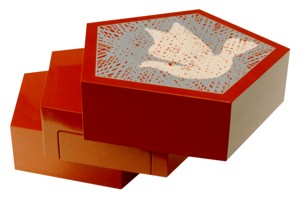
This is a three tiered coffee table I built. I included a linear graphic message on the top. The finish is an automotive enamel that still looks the same today (2021).
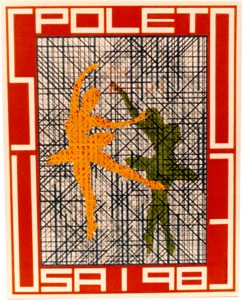
The Dancer – Silkscreen on paper. 24″ x 18″. I made this as a concept piece for Spoleto 1983. I don’t think I displayed it anywhere during the festival.
1984
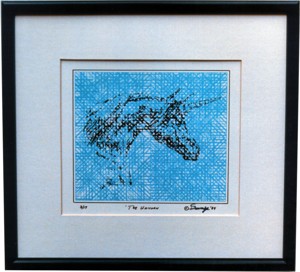
The Unicorn – Silkscreen on paper framed with a wide mat.
I spent a lot of time traveling back and forth to New York City where I would consult with artists, designers, packaging producers, marketing experts and the like. My cousin Susan, who lives in Bay Ridge, would set up appointments for me and off I went. This was all in an effort to come up with a viable commercial product.
This year I decided to invest in some market research. I hired a firm in Boston to do some mall interviews. I wanted to gather input from consumers regarding these linear graphic prints. That research was extremely positive. It was a small study, but the results were intriguing.
I should have followed up and produced a quantity of prints with the goal of getting them into local retail locations. But I didn’t do that. One possible explanation – I didn’t believe the research data. That may have been a huge mistake that set me back over thirty years. In the back of my mind was another nagging thought, probably the most dominant. I just didn’t see people taking these prints off the wall to read the message.
Furthermore, there’s a learning curve involved – how to read them. There were no cell phones or Internet in those days to disseminate information, so instructions would have to be included with each piece. Not a real big problem however.
As I think back on these issues today, I should have taken a lesson from the bar challenge. People were intrigued when told there was a message on the paper. That same feeling probably would have occurred when told there was a message in my print.
Do you remember the stereograms in the mid 90’s. When people were told there was a hidden image that required relaxed vision to see, they couldn’t believe it. People bought those prints hoping they would eventually see the image. A marketing success based on curiosity. My prints might have achieved the same success had I not had my doubts. I just didn’t commit.
1985
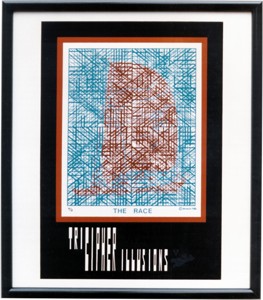
This was a slow year. Too many things to do and not enough time to do them.
This print is called The Race. I began experimenting with different catch all names for my work. I now called my prints Tri Cipher Illusions. That sounded catchy. It also imparted a clue about the print.
Did I initiate a print run and try to market the thing? No! I was still stuck on the notion that people would not take the prints off the wall to read them. If they framed the print with glass the opportunity to read the message was gone. Double trouble.
The Introduction of Ciphers
This is the 2021 me writing. I no longer can pinpoint the day I introduced ciphers (codes) into my work or how I became interested in them in the first place. I am taking a clew from the piece above. The word ‘Cipher’ appears in the description. I have to assume this print contained a code that needed to be deciphered.
1986
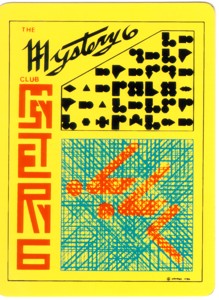
Another concept explored, the Mystery 6 Club. Its been a long time since I worked on these 3×5 plastic cards. I can’t remember all the particulars. I know it involved a deck of these cards, linear graphics, and some strange black symbols.
Packed away somewhere may be a folder explaining this concept. I don’t think I would have thrown the cards out.
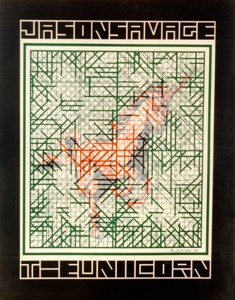
The Unicorn – Silkscreen on paper. 27″ x 25″. This is a quad panel print. It has to be rotated 16 times to read the entire message. I framed the print and used glass for protection. Today if I wanted to read the print I would have to disassemble it. I have it hanging on my bedroom wall (2022).
I knew there was an inherent problem with these prints, especially the larger ones. Even if they were not framed using glass, it was a hassle to take them down, put them on a horizontal surface, and then rotate them numerous times. That just wouldn’t be practical. However, I saw no solution.
Somewhere I read about a fellow who helped introduce Trivial Pursuit into the United States. I don’t remember a great deal about him. He might have worked for Selchow & Righter, the NY firm that purchased the rights to produce and market the game. I called this fellow, and he seemed very interested in what I was doing.
Today (2022) I would have done everything electronically. In 1986 I decided to fly to New York for a day to meet this man and get his input. I took this unicorn print with me. He liked my work and understood the concept. He made a parting comment, “You’ve got a problem.” As if I didn’t know that. He felt that removing a print from display to read the message was a killer as far as marketing was concerned. He could offer no solution. A done day in New York. Off to home I went. This issue would burden me for the next thirty-four years.
1987
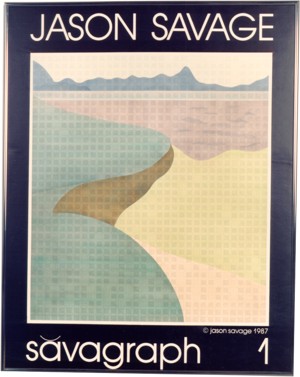
I couldn’t stop thinking about removing a print from display to read its message, so I stopped working with my linear graphics. It was hard to leave an idea I had been working on for years, but no one, including me, could come up with a solution.
I changed the product’s name to Savagraph. Instead of linear graphics I switched to symbols. I designed symbols to represent letters, numbers, punctuation, and blank spaces. A symbol sheet would be included with a Savagraph.
An inquisitive viewer could use the symbol sheet to translate each graphic into its corresponding letter, number, or punctuation. These would be written down on a separate sheet, starting at the top left and proceeding from left to right, top to bottom. The print is viewed straight on. There is no need to remove it from display. Framing with glass is now OK. Problems solved. This approach may be the answer to a successful introduction and marketing campaign.
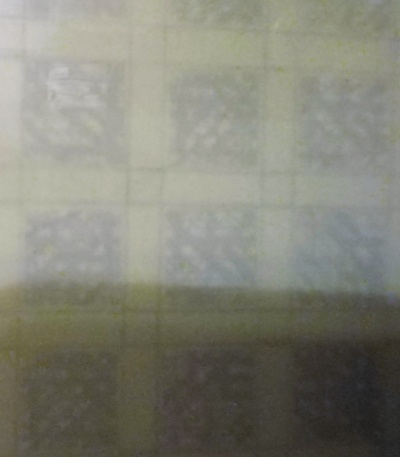
This is not a good photo, but it will give you some idea of what the symbols look like on Savagraph 1. This piece has one problem, the symbols are too small. That can be easily corrected. The addition of this design would give more fire power to my portfolio.
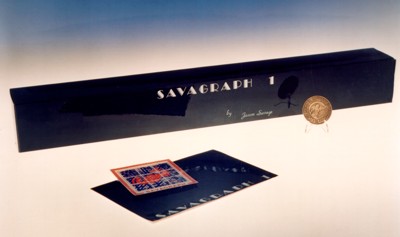
Packaging design for Savagraph 1. When the print’s owner deciphered the piece they then became eligible to receive a specially minted coin.
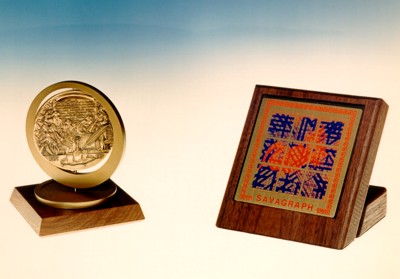
These are other reward options.
A New York State of Mind
During the past few years I have been making regular trips to New York City, staying with my cousins and meeting with artists, designers, marketing experts, and promoters. At one point I worked with an artist agent who lived on Roosevelt Island. This lady introduced me to a lot of interesting people.
I vividly remember this one gentleman who presented himself as an art collector. He looked more like a gangster. I was a little nervous about meeting him at his downtown warehouse. I threw caution to the wind and met him there.
He had canvases stacked up all over the place, all sizes and descriptions. I didn’t know what to make of it. After listening to my story and reviewing my portfolio he made an offer to buy the rights to all my work. That’s right – everything. We didn’t get around to talking about money. I turned him down before we could get to that. I wasn’t going to give up the rights to my work. I wasn’t in the mood.
Looking back on that day, I was naive and foolish. Maybe this guy was going to offer me a million dollars or a hundred dollars. I’ll never know. I was so determined to commercialize my work that I lost perspective. I had traditional options to pursue, but I did not. Its been a long, hard road.
1988
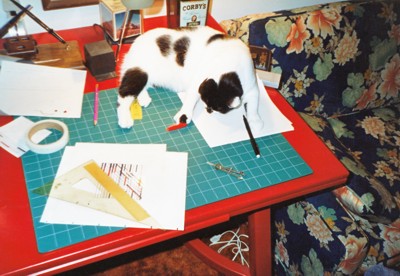
Zoe, the animal love of my life, is helping me with my design work. I was still doing everything the old fashion way.
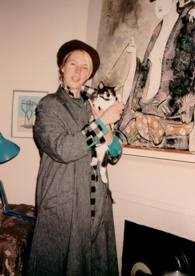
Kata Billups and Zoe in her Charleston apartment. There’s a great story about this full rumpy Manx cat. I got Zoe from Kata because she was getting married and couldn’t keep the kitty. Zoe in Greek means life in all its manifestations. Read all about Zoe in my autobiography, now on CD.
1989
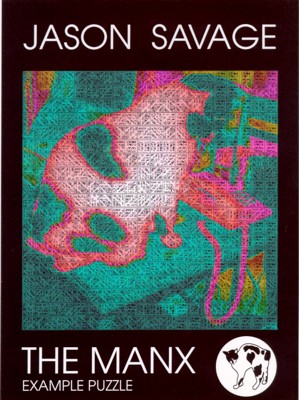
I’m experimenting with names again. I used a photo of Zoe on my work table for this piece. Like the 1987 Savagraph, I used individual symbols to represent letters, numbers, and punctuation. I did increase their size for easier identification. This was just another experiment and addition to my portfolio. I still can’t stop thinking about my linear graphics. No effort was made to commercialize The Manx puzzle.
1991
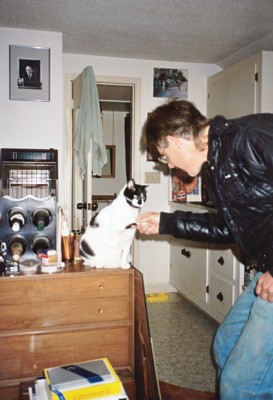
Zoe congratulating me on my work. The sad fact is I haven’t done much with the art in the past two years. I think about my linear graphics almost every day. I still do experiments. How could I keep from taking the prints off the wall to read a message or decipher them. I couldn’t come up with an answer. I’ve mentioned this to friends and colleagues, but they had no solution. Its been nineteen years since I took the bar challenge. Time is relentless.
1995
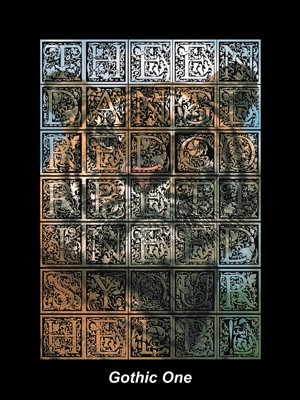
I kept doing my experiments with linear graphics and coded puzzles. By this time I was doing all my design work on the computer. That gave me much more latitude.
Gothic One was designed for Dr. Michael Bleyman, tiger expert and founder of the Carnivore Preservation Trust. I worked with him and his tigers until he passed away due to kidney cancer at the age of 58.
Gothic One is composed entirely of Gothic letters that I hand drew. My puzzle work had taken on an entirely different form. If you would like to see more of my recent puzzle work please visit The Tribute Master.
I have been very busy over these past six years. I spend quite a bit of time training for road races. See my Your Running Memories website. To learn a little more about what’s kept me busy see Meet the Designer.
1996
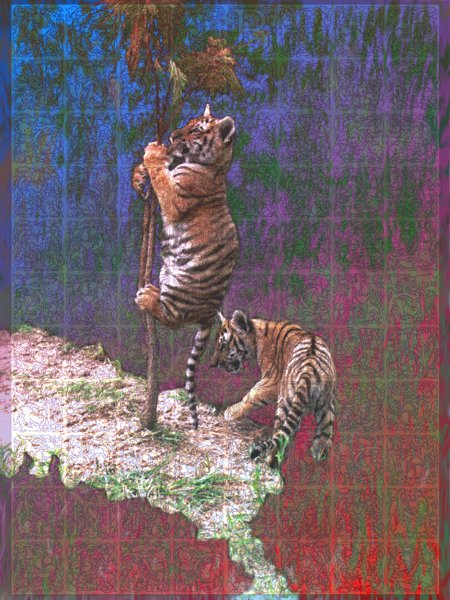
Working with Dr. Bleyman and his tigers was inspiring. A dream come true since I saw my first tiger interaction at the San Diego Zoo. I designed this puzzle featuring the photo of two cubs taken at the preserve.
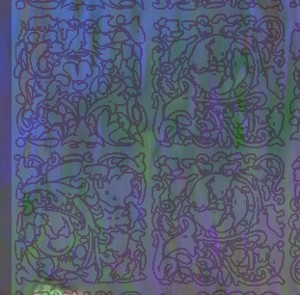
This is a close up of the symbols used in the Cub Puzzle. They are much easier to identify.
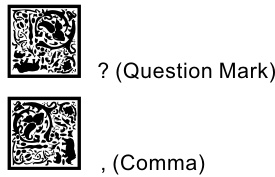
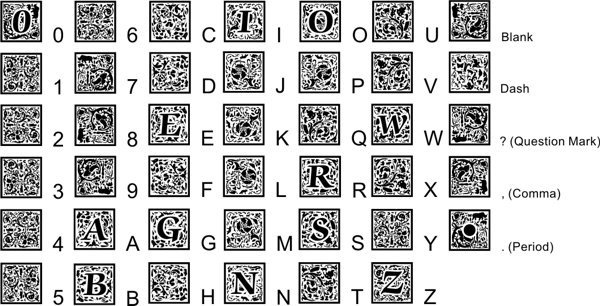
The symbol set with corresponding letters, numbers, and punctuation.
2000
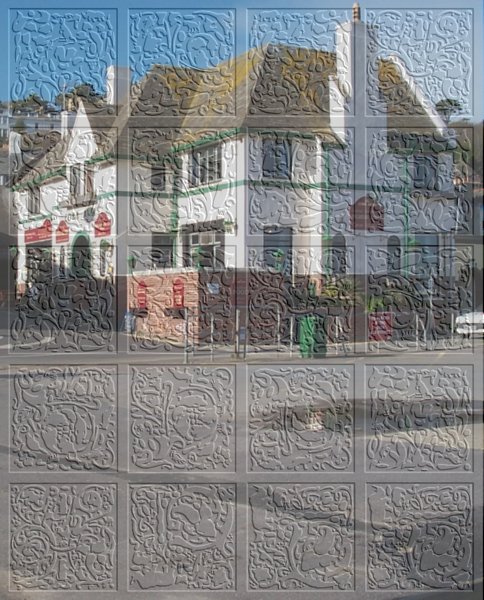
Its been four more long years. I still try to come up with an answer to my dilemma. Either stop thinking about my linear graphics concept or come up with a solution. The bar challenge is what got me started on this very long and frustrating journey.
My trips to New York ended years ago. I couldn’t find the answer there. I have been concentrating on constantly improving my symbol substitution puzzles. They are now much more sophisticated. I could have produced enough work to put on a show, the traditional way to introduce an artist/designer. I probably should have considered that route decades ago, but I couldn’t let go of my passion to pursue my linear graphics concept. Although, if I had pursued marketing The Unicorn in 1984 things might have turned out differently.
2020
Brain Dead
Candidate for Ripley’s Believe It or Not?
The End of a 35-Year-Old Quest
I was taking a fresh look at The Unicorn (1986 version) hanging on my bedroom wall when I had an epiphany. The solution was so simple everyone overlooked it. Totally unbelievable! The perpetual question – how do you keep from taking a large print off the wall to read the message or decipher the code? – was solved. Why couldn’t I, my friends, my many consultants or my colleagues figure this out for thirty-five years?
No One Gave Thought to using a Camera
I was looking at the framed unicorn print I did back in 1986. Then, for some reason, I thought about the camera in my phone. Everyone is taking pictures with their phones these days. I had an older phone that didn’t have much of a camera, so I got out my Nikon and took a photo of the framed print.
As you might recall, The Unicorn has four quadrants. I brought the photo up in Corel PhotoPaint. I masked one of the quadrants then copied and pasted it as a new image. I corrected perspective distortion and resized it to fit on a standard piece of paper. I printed the image, viewed it horizontally and read the letters. Voilà. Problem Solved. And I’m still living to talk about it.
My 50 year quest to produce a large piece that could be read and deciphered without having to take it off the wall has begun. I’m working on a six foot by six foot, linear graphic cryptogram. I’ve formulated the content which I will now encode. I need to complete the instruction sheets. I’ve got a lot of work to. Look at my home. I’ve got test prints everywhere. Over the years I’ve made thousands upon thousands of them. I am confident that I can now produce a cryptogram that no one will forget.
Note: Beeple, the graphic artist who produced Everyday’s, and I have two things in common. First, he produced thousands of pieces which enabled him to design Everyday’s. I produced thousands of test prints over fifty years as a way to refine my trademark element. Unlike Beeple, I did not save very many of those tests. My concentration was on the linear graphics component and how best to make it readable. Saving the tests never occurred to me. And second, we are both Charleston artists.
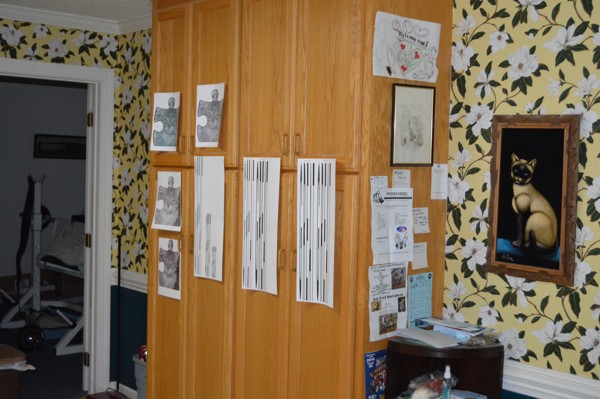
There are tests all over the house.
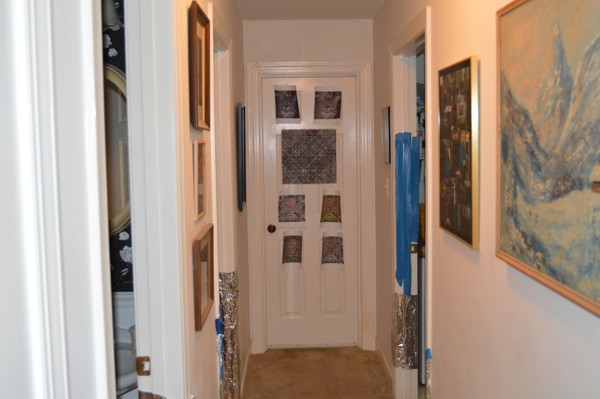
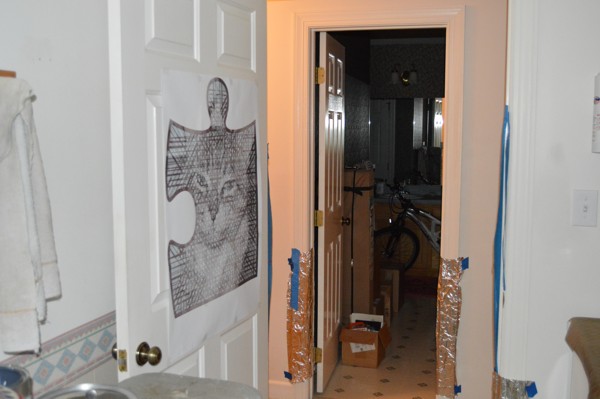
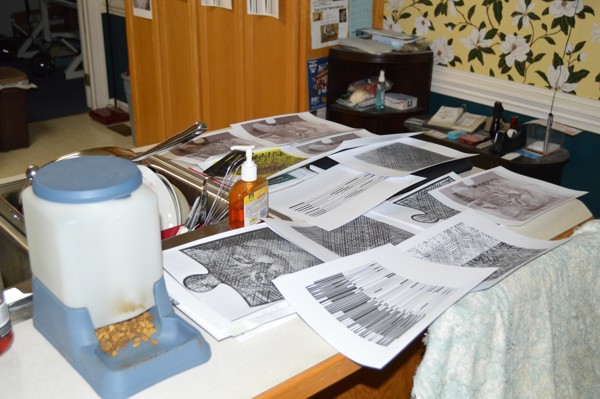
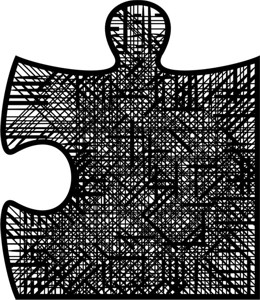
Linear lettering conforming to a puzzle piece shape.
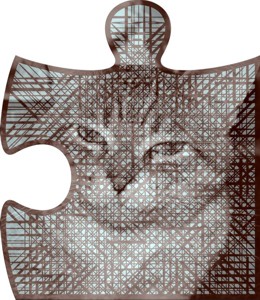
Linear lettering conforming to a puzzle piece shape incorporating an image.
06/01/2021
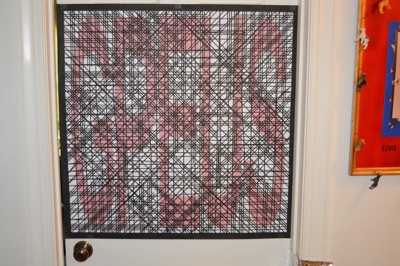 A full size, two foot by two foot test piece that incorporates a code on top of a code. One is read vertically, the other horizontally. I photograph each test piece and print it out on a standard sheet of paper to make sure it can be read.
A full size, two foot by two foot test piece that incorporates a code on top of a code. One is read vertically, the other horizontally. I photograph each test piece and print it out on a standard sheet of paper to make sure it can be read.
The first Trithemian Web™ Cryptogram will not use the more sophisticated techniques I’ve developed over the years. It will incorporate a stereogram.
Update – 10/10/2021
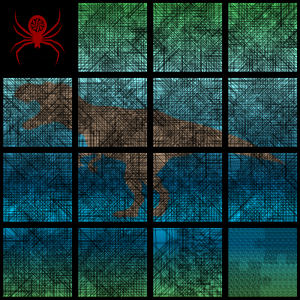
My work has become much more sophisticated over the years. The first, large (72″ x 72″) digital Trithemian Web™ Cryptogram has been completed. I have ordered a 20″ x 20″ canvas and a LumaChrome HD that should be delivered sometime next week. Minting the piece as an NFT is being considered.
A relaxed vision stereogram is in the bottom right container.
10/22/2021
The prints are in. I had a miniature (20″ x 20″) produced in a LumaChrome HD and an oil on canvas. Both are gorgeous. The LumaChrome HD is a more contemporary look.
A Change in Focus
11/18/2021
The 2020 Photograph Revelation is not totally dead, but its necessity
for use is more limited than first envisioned in 1986.
Christie’s sale of Beeple’s ‘Everyday’s: the First 5000 Days’ altered my fifty-year focus. Due to the rising popularity of digital art, NFT’s, crypto, the blockchain and digital art marketplaces, the need for a person to visit a display, take photographs of my work and then decipher one of my cryptograms is no longer a necessity, but it is still an option for some pieces.
The photography method will still work if a person has access to one of my printed pieces that contains the keyword within the body text or is incorporated within a stereogram. How to determine that is explained on the ‘How To‘ page. Select Decryption. Otherwise, they would need the digital file to reveal the keyword. The digital file will only be available to those purchasing one of a limited edition or a single edition original.
There is a digital file on this website that can be deciphered. It offers a potential collector, or simply the curious, an opportunity to interact with one of my cryptograms. One can practice revealing the body text and the title of the graphic. That same procedure will work with any digitally available Trithemian Web™ Cryptogram.
There is another procedure I just incorporated. I use a technique that can only be triggered on a digital image. Implementing the technique reveals the keyword and other blended elements. These elements cannot be revealed by photographing a print of a digital image.
These pieces are difficult to produce, taking a massive amount of concentration. How long I can keep producing new work is anybody’s guess. I am considering minting my cryptograms. I will make an announcement regarding NFT availability on this website (Drops), Twitter (@trithemian), and Instagram (@trithemianweb).
March, 2022
Jack Hanley Gallery – Reporter Zachary Small
“Winkelmann remains bullish on NFTs, pairing each physical work with a blockchain-based collectible for authentication purposes.”
I agree with Beeple on this. A pairing of the physical and digital is optimal. The procedures needed to unveil the mysteries of my work can only be accomplished using the digital file, which can be delivered via the Internet or thumb drive. However, one can best appreciate the complexity of my work by viewing a full size LumaChrome or oil on canvas print. Comparatively, it’s the difference between watching a movie on television and seeing it in an IMAX theater.
June 8, 2022
Increasing the mystique of my work drives my creation. I’ve added blending to my repertoire.
July 11, 2022
I Have Coined a New Art Movement.
August 16, 2022
September 29, 2022
I just read a very good article in Artnet News by art critic Ben Davis evaluating the present NFT market. I hope the market, as far as art is concerned, will rebound. I still believe that minting NFT’s is a viable opportunity for artists who have limited means of promoting their work. Minting creates an indelible record of ownership.
This will conclude my fifty year history. I will record future updates and developments on my blog.